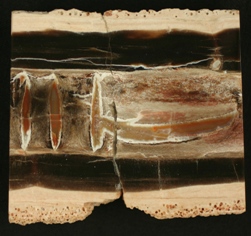
EXCITING
For the team, the scientifically most valuable find was found lying horizontally, embedded in the tuff. It is the more than 10m multi-branched terminal portion of a woody horsetail-tree (
Arthropitys bistriata). It has been named German "Fossil of the Year 2010", the first time a fossil plant has won this accolade, as it shows for the first time that these giant sporing plants from the Permian could be branched, and challenges the assumption that the Permian forms were never branched.
For me, however, the most exciting find was something that was originally thought to have been a rooting system of one of the large seed plants (which in itself would have settled many questions about how the stems were really rooted). This, in fact, turned out to be the broken-off crown of a medullosan pteridosperm tree, with the branches still attached, preserved upside-down! Painstaking excavation with fine chisels and paint brushes revealed that the very long, flattened branches of the inverted tree-crown had pinnules of the fern-like foliage attached, and although not fertile, this specimen represents the first known example of how such large branches (with foliage) were actually borne by the medullosan pteridosperm trees on comparatively slender trunks.
This glimpse into the world of the Sakmarian is extremely valuable; there is a notable decrease in the fossil plant record (when compared with the Carboniferous) as the terrestrial Permian record is often represented by hiatuses or unfossiliferous strata. This rare parautochthonous flora also bears evidence of a drying environment that would have had little preservation potential, had it not been for this lucky volcanism. Some intriguing questions remain, particularly around the taphonomy. What processes led to many of these petrifactions being preserved by purple calcium fluoride, rather than being silicified, for example?
For me, the most unexpected part of the fieldwork was the interest that local people took in our excavation, and the plants we uncovered. The site itself was less than two metres from a road and was overlooked by multi-storey apartment blocks. For safety reasons, the site was walled off; but numerous visits were made by many different groups, (6000 visitors from Germany during a few weekends when the excavation was opened to the public, as well as 80 scientists from more than 20 countries who also came to see the site). Many volunteers laboured long and hard in the hot sun, breaking up the tuff and clearing it by hand, vigilant for any interesting structures, while others (including me) sat with small chisels and brushes cleaning the delicate structures before noting their measurements and directions, then photographing and removing the fossils.
We also digitally mapped each fossil so that a complete picture of the finds in the site has been accurately recorded in 3D. The combined effort of so many genuinely interested people was great to be a part of (even for a short time). Due to the unexpected interest in recovering the Petrified Forest, the city of Chemnitz has granted a new site for excavation, in the Sonnenberg area of the city, next year.
Meanwhile, we are getting on with preparing the specimens and comparing them to existing collections in Berlin and publishing the results – all the time looking forward eagerly to grubbing around in suburbia once again, in 2011.